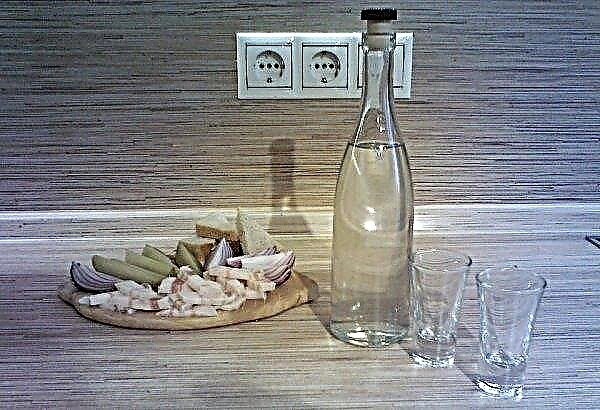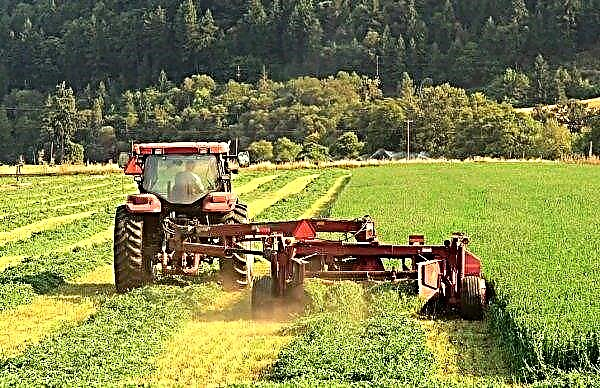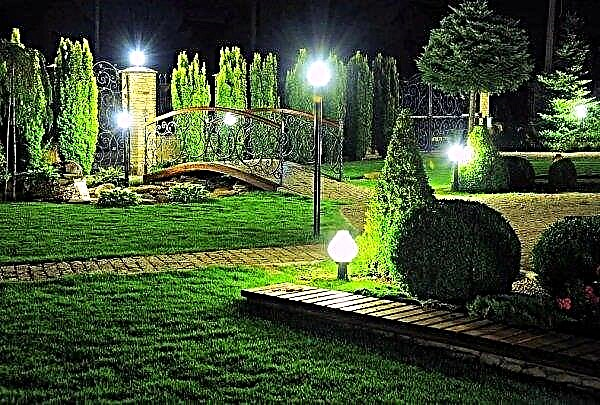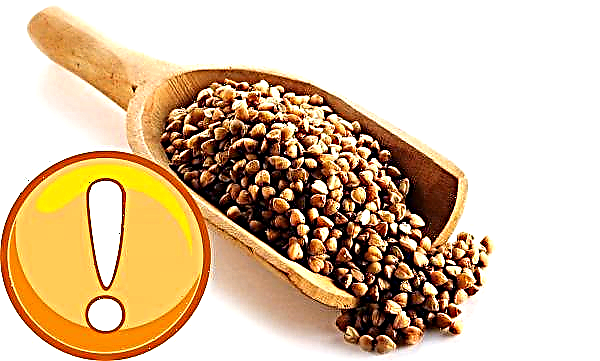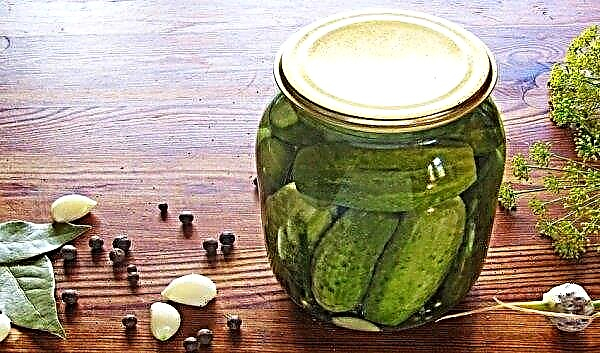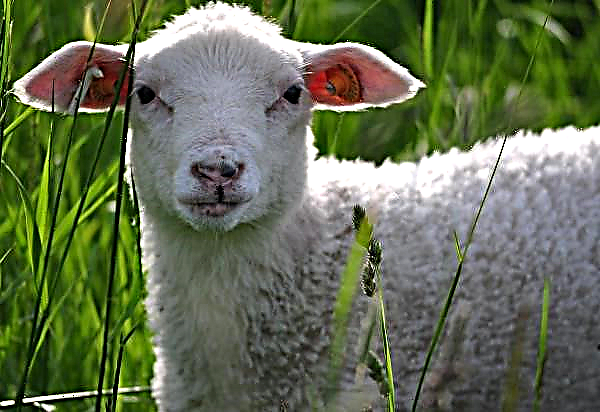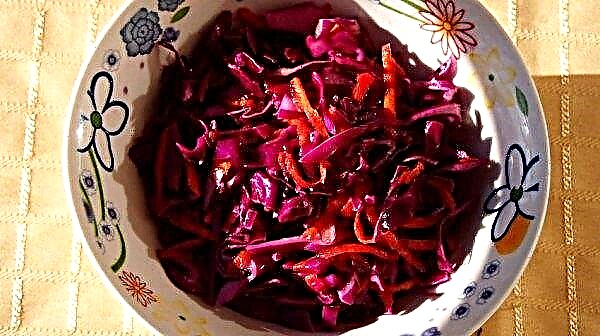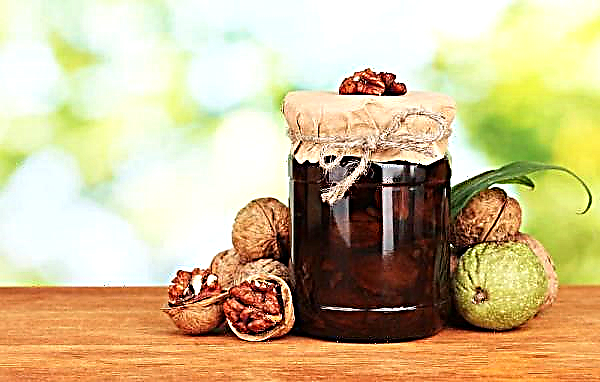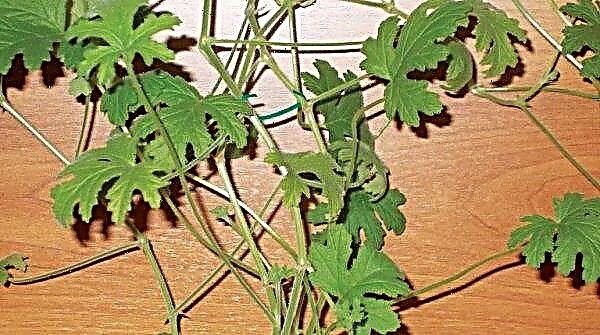The list of the most beautiful and unpretentious plants includes hydrangea growing in domestic gardens. Her delicate flowering and variety of varieties can not leave indifferent any grower. And, despite the fact that the flower looks powerful enough, in fact it is fragile and tender. Therefore, timely and correct pruning of hydrangea is an important step that should be followed in the process of caring for the plant.
Why prune hydrangea, when and how to do it right
The pruning procedure for hydrangea is carried out so that the inflorescences are large in the future, and the bush pleased with lush flowering. If you do not cut off unnecessary inflorescences, the bush itself will be quite thickened, which will lead to the formation of small flowers. In addition, it is used so that the florist has the opportunity to form a bush of the desired shape. In order to form, you need to remove only all those inflorescences that are very small. As a result, the gardener grows only powerful and lush shoots, or just 1 shtamb.
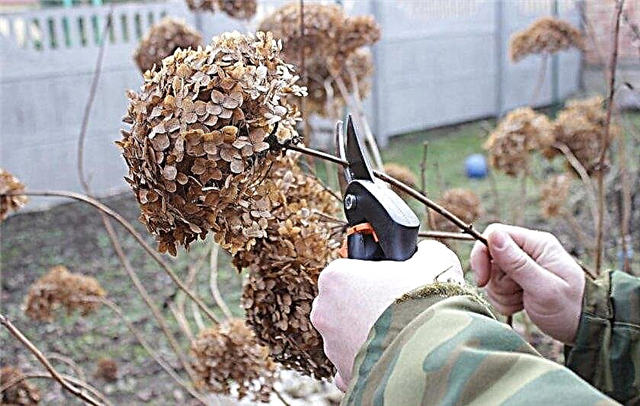
Other nuances indicating the need for regular pruning include:
- giving the bush a beautiful decorative appearance;
- the formation of the correct form;
- obtaining full and large flowers;
- the ability to turn a regular bush into a standard plant.
Did you know? By adjusting the alkalinity and acidity of the soil, each gardener can independently control the color saturation of hydrangea.
In addition to the question of why to cut hydrangea, people often ask when, namely, in what time period this procedure will be correctly implemented.
The peculiarity of such a plant is that it is cut in such periods:
- in the fall;
- in the spring;
- in summer.
Depending on what the purpose of the cropping is, a certain period is selected in which this action will be carried out. Autumn is the best period for pruning tree and panicle hydrangea. This can be done even when the very first frosts pass. This is due to the fact that with a sharp onset of cold weather, leaves from the plant will quickly fall off and only bronze dry inflorescences will remain. Thus, you can quickly determine which shoots should be disposed of and which ones should be left.
Video: Pruning Hydrangea Trees in Autumn
therefore in the fall season, the best period is the end of October or the beginning of November. As for a season such as spring, during this period it is also possible to trim both tree-like and panicled hydrangea. But it is better if this action is performed in several stages: one part is cut off in the fall, and the second when spring comes. Only spring pruning should be done for large-leaf hydrangea.
Important! After the autumn pruning of inflorescences, it is very important to prepare the hydrangea shrub for the future wintering.
Summer it is considered to be an infrequently used period, but this season such manipulations are carried out if the gardener wants to constantly look after the appearance of the plant and thereby rejuvenate it. Winter is the season in which you should refuse to trim any type of hydrangea. Before you cut off the shoots on a plant such as hydrangea, you need to determine what species grows on your site, since not only the period of the year in which you need to perform this action depends on it, but also the rules by which you must follow these manipulations.
Among all species, one can distinguish the following:
- large-leaved;
- ground cover;
- panicled;
- tree-like.
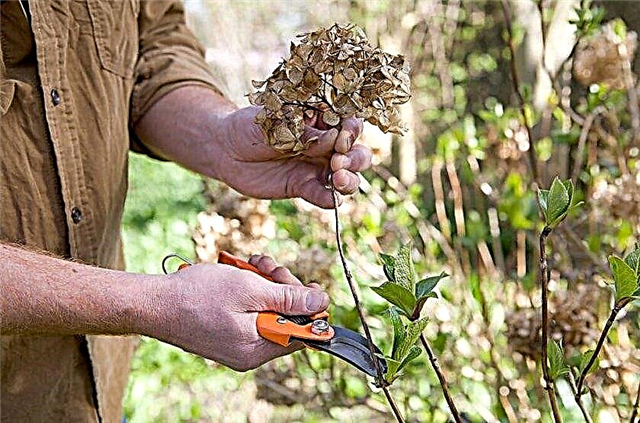
The large-leaved species carries out its flowering on last year's shoots, so from the very beginning of autumn they have been implementing the process of laying the shoots. Therefore, in large-leaved hydrangea, pruning often occurs for sanitary purposes. In this case, too thick bushes are thinned out, elimination of those shoots that are damaged and inflorescences that have withered or dried out is performed. Ground cover is also not subject to deep pruning.. In order for its development to occur in a normal mode, every year you need to take care only of shortening those shoots that are too long.
Did you know? The birthplace of hydrangea is Japan, namely the mountainous regions located in the area of the Japanese islands.
A tree-like and panicled species of hydrangea is most often found, therefore, the main process of trimming them is carried out in the spring. At the same time, it is worth paying attention to the fact that the more often this procedure is performed, the more successful the flowering of the plant will be. Depending on what the weather conditions will be, the period that can start from early March to early April depends.
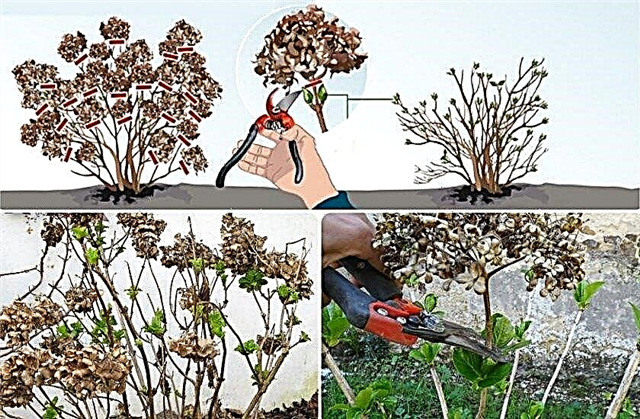
Trimming Types
When caring for hydrangea, a variety of trimmings can be used, which should be considered in detail:
- Formative - carried out in the very first years of the plant’s life. During the first three years after hydrangea has been planted, pruning must be performed, which forms an element such as a crown. Particular attention should be paid to skeletal branches that stand as a support.
- Regulatory - This species is also called stimulating, since it makes it possible to create a beautiful and lush garden bush with the likelihood of maximum flowering. This type of pruning will ideally combine with thinning, since hydrangea tends to thicken.
- Anti-aging - a mandatory species that helps to cope with old and dried branches that can interfere with the growth of young shoots.
- Sanitary - pruning, which occurs in the autumn, when the plant is already fading. Such annual care will allow you to get rid of old, sick, damaged and broken branches. Radical sanitary pruning is necessary in cases where hydrangea is seriously ill.
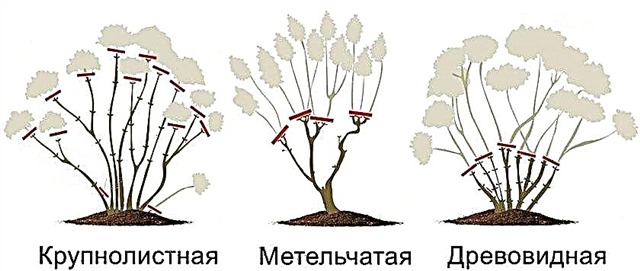
Pruning after flowering
As soon as the hydrangea begins to fade, you need to think about its future pruning. Many gardeners are confident that the more often this process is carried out, the thicker and more magnificent the plant will bloom. But at the same time, it is worth paying attention to the fact that this is not good for each species, since large-leaved trees can not be cut very much, and the tree-like and panicled variety need a similar procedure.
Important! Crop (not forming) hydrangea, which is not 2-3 years old, is strictly not recommended.
Do I need to crop
Asking the question of whether to cut hydrangea, we can unequivocally answer that this process is necessary depending on the type and variety that the grower encountered. The flowering of large-leaved hydrangea occurs on last year's shoots, so those new branches that grew in the summer season must necessarily be wintered so that their flowering can be observed next year.
If we consider panicle and tree hydrangea, then they bloom only on annual stems. And if, after flowering, crop them, then next year you can get many new shoots with a huge number of flowers.
Video: How to prune hydrangea
How to crop
A very important nuance that should be adhered to is compliance with hydrangea pruning rules. The best time for this is spring, but in this case you need to be extremely careful, as juice can still ferment in the shoots. In this regard, gardeners believe that it is better to do this procedure on the contrary in the fall.
Did you know? Interestingly, on January 5 (out of season) is an international day of hydrangeas.
Pruning after flowering large-leaved hydrangea can only be cosmetic, when there is a need to get rid of last year's inflorescences or very old branches. Before the start of the growing season in the spring season, it is necessary to prune panicle and tree hydrangeas. Moreover, the latter species can be subjected to this procedure only if the plant has already 4 years. In the opposite case, it will die, as it simply expires with juice. If this action is performed in the fall, then this problem can be avoided.
For rejuvenating an adult or an old plant, only 10 cm are left when pruning from shoots. If the bush is large enough, then it is advisable to divide this procedure after flowering into several stages. Trimming panicled hydrangea should be as moderate as possible without affecting those branches that are considered skeletal. If several shoots grow from the same point at the same time, then you need to leave the one that grows outward.

Optimum cutting time
Planting, compliance with the conditions under which hydrangea grows and care for it, are not the key factors that will contribute to the fact that next year the ornamental bush will grow and bloom well. This process is also facilitated by not only correct, but also timely pruning. It is known that the most popular are the autumn and spring method.
Important! Sanitary pruning of the plant is preferably carried out before the buds open, since in the opposite case it can be very sick.
And if pruning in the autumn season is mainly carried out in order to get rid of old inflorescences, then we can say with confidence that the best time for this action will be considered early spring. This should be done when there is still some snow on the soil, and the kidneys are already slightly swollen. Often this falls in March or early April. If the street is cool enough, you can drag out a little time, until the end of April, but no later.
The type of flower is also an equally important factor on which the period depends. For tree hydrangea The best time will be the beginning of March. In April, you need to start pruning panicle hydrangeas. And here for large-leaved species this procedure should be carried out an order of magnitude earlier, subject to a special scheme.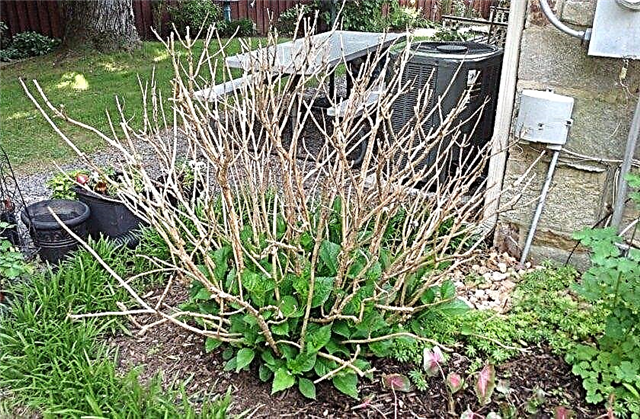
Spring pruning
As soon as hydrangea begins the process of swelling of the kidneys, you can safely proceed to pruning it. This is due to the fact that it is during this period that one can clearly see in which direction young shoots will grow. In the future, this will protect against improper pruning of the plant. Until that moment, until the kidneys are clearly distinguishable from each other, you should not start this procedure. At the same time, it is worth paying attention to the fact that if spring pruning is too long, this will lead to a process when the bush does not bloom in time, and in the future does not even have time to get ready for wintering.
Treelike hydrangeas should be pruned first in spring, and then panicled, as they are more resilient and patient. For large-leaved, which blooms on last year's shoots, it should be carried out as early as possible, but in a completely different way.
Did you know? Despite the fact that hydrangea has a Latin name, it consists of two Greek words, which in translation means “vessel” and “water”, which indicates the hydrophilia of the plant.
Pruning in autumn
For adult hydrangeas, autumn pruning is a mandatory process carried out annually.. This should be done only when all the yellow leaves have completely fallen, and the flowers have completely dried up. First, start it with the smallest branches that go deep into the crown or do not give large flowers. After this, the inflorescences are cut off and the skeletal branches are shortened to the length that is needed.
In that case, if the gardener correctly performs the autumn pruning, then by the onset of spring there will be no need to form a bush. You only have to cut those ends of the shoots that were slightly damaged by frost.

Pruning in summer
As for pruning in the summer, then in this period of time, only the regulatory and formative form can be implemented in practice. This is necessary so that the process of further hydrangea cultivation makes it possible to get a truly beautiful, flowering and lush bush.
Features of pruning different types of hydrangea
To preserve the beautiful shape of the bush and constant flowering, it is necessary that for each type of plant certain features are observed. Therefore, it is worth familiarizing yourself with the nuances of cutting large-leaved, paniculate, and tree-like hydrangeas.
Important! When performing full pruning in the autumn, in the spring it is recommended to perform sanitary pruning in addition to get rid of broken and extinct branches.
Tree-like
The best time for pruning hydrangea is spring. In autumn, it is necessary to eliminate those inflorescences that have already faded.
For this species, a procedure consisting of the following steps should be carried out annually:
- sanitary - consists in eliminating broken branches and last year's shoots;
- anti-aging - there is a cutting of those branches whose age has reached 3-4 years up to the very base of the plant;
- thinning - cutting out those small shoots that cannot bloom, those that grow in the center or overly thicken the bush;
- on flowering - growths have been shortened since last year, while about 2–4 living buds should remain on them, from which shoots may appear in the future.
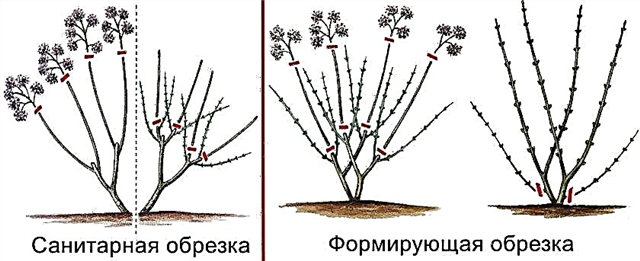
Panicle
Panicled hydrangea occupies a special place among the most popular garden crops. Everything superfluous in the plant is necessarily removed, since last year's shoots form new branches. If there are branches that come directly from the ground, but they are very weak, they are also cut out. The most optimal period is spring, and in the autumn season you can get rid of inflorescences that have bloomed.
Did you know? In Japan, hydrangea is referred to as adzisai, which translates «sunny purple flower».
For panicled hydrangea, it can be as follows:
- sanitary - elimination of those branches that have broken or dead and dried shoots;
- anti-aging - occurs closer to pruning a tree while maintaining skeletal and main trunks with cutting only those branches that are old and whose growth is gradually decreasing;
- thinning - clipping of small branches growing in the inner part of hydrangea, which does not allow the formation of large inflorescences. If 3 absolutely young shoots grow from one point, then only 1-2 branches are left that carry out growth;
- on flowering - The process of shortening all the shoots that have remained since last year, on which there are approximately 1-3 buds. In the future, this will enable the formation of new shoots with beautiful and large inflorescences.
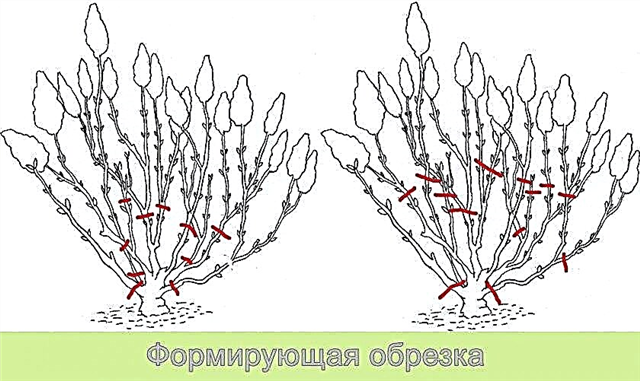
Large leaf
Large flowering hydrangea is a typical flowering shrub, which is unique in that zero shoots are formed on it annually.. After this, shoots, which are 4-6 years old, can be considered old and cut out. In winter, it is very important for this species to preserve non-flowering and young shoots together with the tops, which will provide violent flowering next year.
A key feature of this species is that there is no need to shorten the shoots. This should only be done if they are frozen. If you make a sufficiently strong shortening, then a situation may occur in which hydrangea next year simply does not bloom.
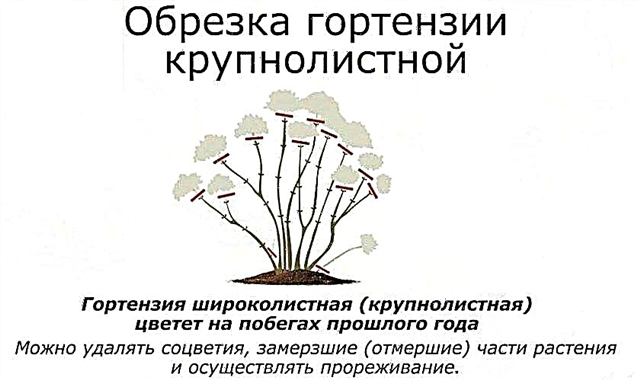
Care after trimming
After pruning, it is very important to observe the features of proper care in order for the shoots to grow as powerful as possible. First of all, it is worth taking care of the systematic watering and top dressing of the plant. It should be watered periodically and not allowed to let the topsoil dry out. At the same time, it is very important that the earth is always a little wet. This will contribute to a fairly rapid restoration of hydrangea.
Important! The specificity of the pruning method used and the need for sheltering the plants for wintering depends on the type and variety of hydrangea growing in the garden.
Feeding should also be done only in moist soil. For this, special mineral fertilizers are used, which contain potassium, nitrogen, phosphorus and many other trace elements. Barrel Circle Mulching It is carried out by manure, compost and peat, the layer of which should be about 5 cm. This will help protect against the formation of a dry surface layer on the soil and retain moisture inside it for as long as possible.

Asking the question, is there a need for trimming hydrangeas, we can unequivocally answer that the procedure presented is extremely necessary. Moreover, it is very important not only to choose the season in which this process will be implemented, but also to decide on which grade it will be performed. Indeed, depending on whether you are dealing with large-leaved, paniculate, or tree-like hydrangea, the features of the procedure for this plant also depend.

